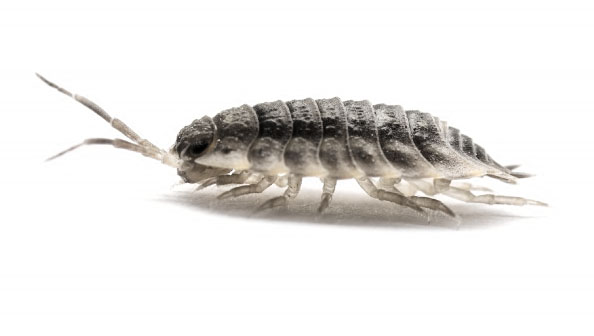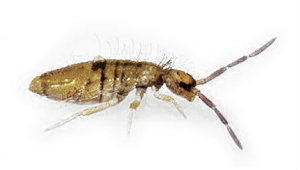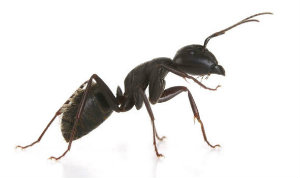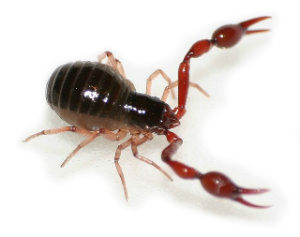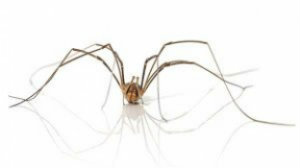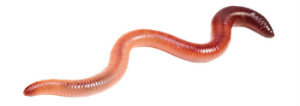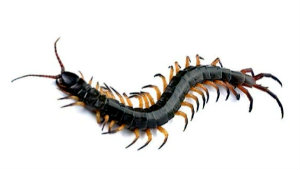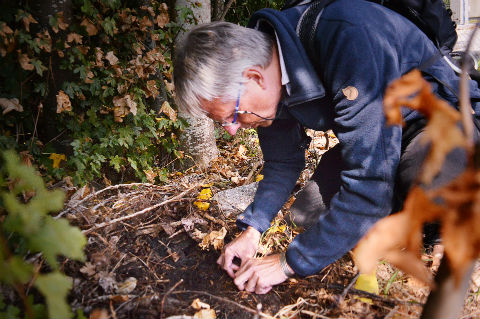
Matty Berg discovered 33 species
Champion of the wood lice
Did you know…
That a female woodlouse has two vaginas and the male two penises? The male woodlouse first fertilises the eggs on one side in the female’s brood pouch, and then on the other side.
The woodlouse is clearly pregnant. On her belly, past her wriggling legs, there is a yellow-ish bulge: the ‘marsupium’, where woodlice carry their eggs for six weeks.
Once the baby woodlice are ready, the brood pouch tears, dropping the small bugs on the ground. There, they gorge on the faeces of other woodlice. This bacteria from this first meal will enable them to digest plant detritus.
But for now, the little grey bug curls her body protectively around the brood pouch. Professor of soil fauna Matty Berg releases her. She quickly burrows back under the dead leaves in the shrubbery near the P5 parking lot at the Zernike terrain. ‘That was a common shiny woodlouse’, says Berg. ‘See the white edge around her shell?’
Millipede
The rotten wood and dead leaves house a plethora of shiny woodlice, which is the same type that lives in houses. Berg carefully picks up another bug, this one small and fast. ‘This is the common rough woodlouse’, he says as the bug skims across his fingers. ‘Feel his body. See how rough it is?’
Did you know…
That springtails can shrink themselves? They moult at high temperatures. They can lose up to a third of their size this way.
He rummages through the dead leaves. He finds another millipede and a harvestman spider. He even discovers a pygmy woodlouse. This particular specimen is noteworthy for being triploid, which means she has three copies of each chromosome, instead of two. This means she can reproduce asexually. It also means she can only have daughters.
Every once in a while, however, the species mysteriously produces a male. Berg have any idea how. ‘It’s one of the many mysteries surrounding soil fauna’, he says. ‘It proves how much we don’t know.’
Big’uns
Soil fauna have been a large mystery in the animal kingdom for a long time. Creepy crawlies make up twenty-eight percent of all animals in the Netherlands, and they spend most, if not all, of their lives rooting around in the soil.
Did you know…
That ants have two stomachs? One is used to digest its own food. His other stomach holds food for the rest of his family, such as soldiers who don’t have time to find their own food.
This means worms, woodlice, centipedes, snails, and earwigs. But it also includes bigger animals as moles. There are also countless animals you can’t even see with the naked eye: mites, springtails, and tardigrades. There are approximately 8,500 different species, and a square metre can house up to eighty thousand of them.
Strangely, almost no one is concerned with their behaviour or their contributions to the ecosystem. Most people don’t even recognise those contributions. But Matty Berg is interested.
Most biologists are only interested in the big’uns. But there is so much more to learn about the small animals
‘Most biologists are only interested in the big’uns’, he says. ‘Dolphins, whales, birds. But there is so much more to learn about the smaller animals. They come in so many different shapes and sizes, and they have so many strategies for surviving in the harsh environment of the soil.’
Did you know…
That pseudoscorpions are miniature arachnids? To travel great distances, they attach themselves to the legs of larger insects or spiders and hitch a ride.
These strategies are vital. For one, the animals can’t see anything in their soil environment. So how do they find each other when they want to mate? How do they even get around? What happens when their environment undergoes drastic changes, such as when rain turns the dry soil into wet mud? ‘They just have to tough it out.’
Soil fauna
Some of them, like moles, dig tunnels. Others, like the springtail, make use of the tunnels and cracks made by other animals. Some of them, like worms, simply eat the soil as they go. Some animals use complex scents to communicate while others use vibrations.
Berg’s first job was at the Dutch Youth Nature Association, where he organised weekend excursions and camps for groups of ten. He taught the kids to identify dragonflies and beetles; over time, he developed an extraordinary knowledge of the various species. ‘That’s not something you learn at the university.’
When he started studying biology and took on an internship at the Vrije Universiteit in Amsterdam, his interests continues to gravitate towards soil fauna. He realised he could actually make a difference in the field. ‘Somewhere in 1990 I found these orange woodlice. I’d never seen them in any of my books, and they turned out to be a species that was entirely new to the Netherlands. That was an amazing moment.’
Did you know…
That harvestman spiders aren’t real spiders? They don’t make webs and they don’t have the venom glands that real spiders do. One thing they do, however, is stink! When harvestman spiders are under attack, they produce a foul-smelling fluid. Sometimes, they grow so fast that their legs get too long. But then they simply bite off a few millimetres.
Since then, he has discovered seven new species of woodlice, twenty new kinds of springtail, and five new millipedes in the Netherlands. He also discovered one species that was new to the world: a pauropoda, an arthropod he named montidiabolus because he found it on Devil’s Mountain, near Nijmegen. This find also meant he had discovered a new Dutch class: the allopauropus.
Secretly
‘It’s on par with discovering a new bird species in the Netherlands’, Berg explains. That particular amazing moment, however, happened while he was looking through a microscope, and not while he was in the field. That’s because his arthropod is so small that it can’t be seen with the naked eye.
And the name secretly refers to himself as well. ‘Monti, as in Berg, which means mountain. Get it? It’s my secret way of giving myself credit’, he grins.
Identifying new creatures is only a by-product of Berg’s work, however. The main focus of his work is to figure out what they do. ‘They aerate the soil, oxygenating plant roots and allowing water to flow away. They break down all the leaves and wood into tiny bits, enabling fungi and bacteria to do their thing.’
Did you know…
That earthworms are blind, but can feel light through their skin? They also have no fewer than five hearts. That is to say, they have an aortic arch that functions like a heart. Australia has the Gippsland worm, which can grow up to three metres long.
He argues that if woodlice and millipedes were to stop doing this work, humanity would be awash in dead leaves; fungi and bacteria would no longer be able to get rid of them. Plants would die due to their roots being cut off from oxygen, and hunters would starve for a lack of food.
How do all the little cogs in the system work together? And how flexible is the system?
Ecosystem engineers
Berg is currently focusing on what he calls ‘ecosystem engineers’: animals that change their environment to their own advantage. Think beavers building dams. But he prefers something with a few more legs: the orchestia gammarellus. ‘It’s a kind of woodlouse’, says Berg. ‘It digs tunnels in the soil. That in turn influences plant growth and other soil fauna.’
Soil fauna is much more important to the ecosystem than mammals
He started his research ten years ago on the grazed part of the Oosterkwelder salt marsh on Schiermonnikoog. ‘The orchestia were bigger the further down on the salt marshes they were. They grow faster and have a better rate of reproduction’, he discovered. ‘Not surprising, since they were originally sea creatures’, he says.
Did you know…
That millipedes are speed demons? They can run up to forty centimetres per second, or a mile an hour. No other soil creature can go that fast.
But climate change has caused the salt marshes to be submerged more often and for increasing periods of time. This means that the top layer of the salt marshes is increasingly becoming the better living environment.
The question is what that means for the creatures that live there now. ‘I want to know if they’re able to adapt to the circumstances, and how fast they do so. And what this means for the process of bioturbation; the tunnels they dig.’
Pieces of the puzzle
There aren’t currently any signs that the soil fauna population is declining, but Berg doesn’t want to wait for that to happen. The creatures are too important for that. Even an animal as small as the orchestia presented him with mysteries, as his study on Schiermonnikoog turned out to not be replicable in other locations on the island.
Berg is now urgently looking for another location with the same salt-to-fresh ratio in the water. ‘There are some pieces of the puzzle missing still.’
It’s a small, albeit important step. ‘People often don’t realise it, but soil fauna are much more important to the ecosystem than mammals.’
Butterflies and bees are protected and provided with insect hotels. Otters, tigers, elephants, and bats each have their own conservationist groups. But who will champion the woodlice or the orchestiae?
Probably Matty Berg.
did you know…
- That a female woodlouse has two vaginas and the male two penises? The male woodlouse first fertilises the eggs on one side in the female’s brood pouch, and then on the other side.
- Did you know… That springtails can shrink themselves? They moult at high temperatures. They can lose up to a third of their size this way.
- Did you know… That ants have two stomachs? One is used to digest its own food. His other stomach holds food for the rest of his family, such as soldiers who don’t have time to find their own food.
- Did you know… That pseudoscorpions are miniature arachnids? To travel great distances, they attach themselves to the legs of larger insects or spiders and hitch a ride.
- Did you know… That harvestman spiders aren’t real spiders? They don’t make webs and they don’t have the venom glands that real spiders do. One thing they do, however, is stink! When harvestman spiders are under attack, they produce a foul-smelling fluid. Sometimes, they grow so fast that their legs get too long. But then they simply bite off a few millimetres.
- Did you know… That earthworms are blind, but can feel light through their skin? They also have no fewer than five hearts. That is to say, they have an aortic arch that functions like a heart. Australia has the Gippsland worm, which can grow up to three metres long.
- Did you know… That millipedes are speed demons? They can run up to forty centimetres per second, or a mile an hour. No other soil creature can go that fast.


